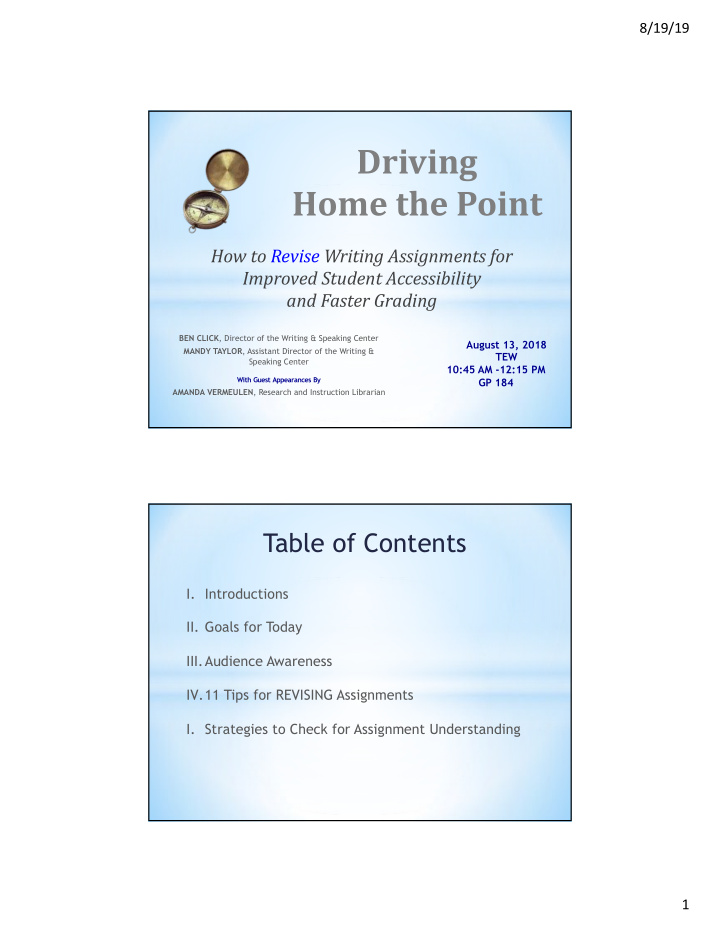



8/19/19 Driving Home the Point How to Revise Writing Assignments for Improved Student Accessibility and Faster Grading BEN CLICK , Director of the Writing & Speaking Center August 13, 2018 MANDY TAYLOR , Assistant Director of the Writing & TEW Speaking Center 10:45 AM -12:15 PM With Guest Appearances By GP 184 AMANDA VERMEULEN , Research and Instruction Librarian Table of Contents I. Introductions II. Goals for Today III.Audience Awareness IV.11 Tips for REVISING Assignments I. Strategies to Check for Assignment Understanding 1
8/19/19 1. Recognize both the obvious and hidden audiences for assignments. 2. Consider assignment revision strategies that maximize clarity for audiences and streamline grading for instructors. 3. Discuss ways of checking for understanding of assignment directions. * Students are the obvious audience for assignments, but other people on campus also sometimes need to use them. * Assignment instructions need to be clear enough for librarians and Center tutors to understand them. * Clear instructions make grading easier. If you can eliminate opportunities for misunderstandings, students are more likely to meet expectations. * The reader is usually right. 2
8/19/19 If you accommodate audiences outside your class (like tutors and librarians), you almost automatically accommodate your in-class audience as well. 3
8/19/19 Put the same amount of thought into writing and revising assignments that you hope students will put into completing them. * Thought and time are different—for students and instructors. * Students cannot get out of an assignment what you don’t put into it. Write the assignment. * Provide hard copies or have students print them so they can highlight, take notes, etc. * Rely on a document, not a memory. * You can’t change the plan until you have it. Cartoonstock.com 4
8/19/19 Keep formatting consistent, and use it to your advantage. * Do this within assignments and across them. * Bold, underline, and color code important information. * Use subheadings to categorize information and indentations to order it. * Number steps that must be done in order. * Balance text with lists, graphic organizers, and other methods of presenting information. * Use space wisely to increase the ease of reading and to allow for student note-taking. Give the assignment a descriptive title— or have students create one after reading the guidelines. * “Essay 3” is not a descriptive title. * If the title describes the actual content and goal, you can reinforce expectations simply by referring to the assignment by name. 5
8/19/19 DO NOT use a multi-question prompt unless you are prepared to teach students how to navigate one, especially if you are teaching a FYS. * Students confuse questions for an organizational strategy. * Students do not know whether to answer one question or all. * Students cannot distinguish guiding questions from the main prompt. * Students cannot prioritize questions by importance. The directions should be as concrete and as specific as possible. * Concrete and specific language facilitates concision and clarity. * Even concrete terms may require additional clarification or specification. 6
8/19/19 Include samples, but be sure to contextualize them. * Are they good or bad? Why? * Are they templates or options? * Should they be separate or embedded? Before recommending resources, teach students what they are and how to use them. * What’s the best way to ask you a question? E-mail? Office Hours? * Can they locate the Reference Desk? Better yet, do they know librarians exist? And what they do? And that they want to help? And how to find and contact them? (Do you?) * Do they know how to make a tutoring appointment at the Center? And how to use it? And who to contact for assistance? (Do you?) * When in the process will each resource be most useful? How have past students benefitted from these resources for this assignment? 7
8/19/19 Build time into the assignment for student revision. * Pedagogically, revision models real-life practices. * Practically, revision buys time in case parts of the assignment don’t work. Students also generally get closer to your expectations over time, so grading will be easier. * Logistically, revision provides a natural point in the process for students to utilize tutoring at the Writing & Speaking Center. Consider where students are likely to get stuck, and see if you can preempt issues. * Are there words or directions they may misinterpret? * Are key details missing? * Does the assignment require skills students have not yet mastered? * What questions are they likely to have? * Did students run into issues in the past? * If someone not taking the class read the assignment, what wouldn’t they understand? 8
8/19/19 Test key aspects of the assignment. * Can you answer your prompt? * Can you find all the necessary sources? * Do all links work and go to the correct sites? * Are all materials where you said they would be? * If you are requiring Center or Library use, have you made appropriate arrangements? * Are steps presented in order? ✓ 9
8/19/19 * Give a True/False quiz on the assignment details . * Have students summarize the assignment verbally or in writing. * Give students a copy of the assignment with key words missing, and see if they can fill in the blanks . * Ask students to write three questions they have about the assignment as homework. * Have students read the assignment for homework, and bury a point or two of extra credit in the fine print . (Shout out to Katy Arnett) * Do a preliminary scavenger hunt to make sure students can locate relevant people, places, and resources. Make sure to get approval in advance if you plan to involve the Center or Library. * Provide a sample draft of the assignment , and have students analyze the extent to which it follows the instructions. * After students complete the assignment, ask them how they would revise the directions for future students. 10
Recommend
More recommend